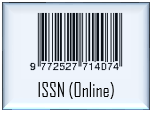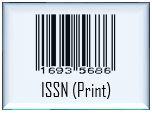PENGARUH PEMBERIAN SUBKRONIK EKSTRAK KELOPAK BUNGA ROSELLA (Hibiscus Sabdariffa L.) TERHADAP KADAR SGPT SGOT DAN ALP
(1) Fakultas Farmasi, Universitas Ahmad Dahlan, Yogyakarta, Indonesia
(2) Fakultas Farmasi, Universitas Ahmad Dahlan, Yogyakarta, Indonesia
(3) Program Pascasarjana Farmasi, Universitas Ahmad Dahlan, Yogyakarta, Indonesia
(*) Corresponding Author
Abstract
Keywords
Full Text:
PDFReferences
Adetutu, A. and Owoade, A.O., 2013. Hepatoprotective and Antioxidant Effect of Hibiscus Polyphenol Rich Extract (HPE) Against Carbon Tetrachloride (CCL4)-Induced Damage in Rats. British Journal of Medicine and Medical Research, 3(4), 1574.
Ajay, M., Chai, H.J., Mustafa, A.M., Gilani, A.H. and Mustafa, M.R., 2007. Mechanisms of the anti-hypertensive effect of Hibiscus sabdariffa L. calyces. Journal of Ethnopharmacology, 109(3), 388-393.
Akindahunsi, A.A. and Olaleye, M.T., 2003. Toxicological investigation of aqueous-methanolic extract of the calyces of Hibiscus sabdariffa L. Journal of ethnopharmacol-ogy, 89(1), 161-164.
Ali, B.H., Wabel, N.A. and Blunden, G., 2005. Phytochemical, pharmacological and toxicological aspects of Hibiscus sabdariffa L.: a review. Phytotherapy research, 19(5), 369-375.
BPOM RI, 2014, Peraturan Kepala Badan Pengawas Obat dan Makanan Republik Indonesia Nomor 7 Tahun 2014 tentang Pedoman Uji Toksisitas Nonklinik secara In Vivo, BPOM RI, Jakarta.
Chang, C.C., Yang, M.H., Wen, H.M. and Chern, J.C., 2002. Estimation of total flavonoid content in propolis by two complementary colorimetric methods. Journal of food and drug analysis, 10(3).
Chen, C.C., Hsu, J.D., Wang, S.F., Chiang, H.C., Yang, M.Y., Kao, E.S., Ho, Y.C. and Wang, C.J., 2003. Hibiscus sabdariffa extract inhibits the development of atherosclerosis in cholesterol-fed rabbits. Journal of Agricultural and Food Chemistry, 51(18), 5472-5477.
Odigie, I.P., Ettarh, R.R. and Adigun, S.A., 2003. Chronic administration of aqueous extract of Hibiscus sabdariffa attenuates hypertension and reverses cardiac hypertrophy in 2K-1C hypertensive rats. Journal of Ethnopharmacology, 86(2), 181-185.
Herrera-Arellano, A., Flores-Romero, S., Chavez-Soto, M.A. and Tortoriello, J., 2004. Effectiveness and tolerability of a standardized extract from Hibiscus sabdariffa in patients with mild to moderate hypertension: a controlled and randomized clinical trial. Phytomedicine, 11(5), 375-382.
Kao, E.S., Hsu, J.D., Wang, C.J., Yang, S.H., Cheng, S.Y. and Lee, H.J., 2009. Polyphenols extracted from Hibiscus sabdariffa L. inhibited lipopolysaccharide-induced inflammation by improving antioxidative conditions and regulating cyclooxygenase-2 expression. Bioscience, biotechnology, and biochemistry, 73(2), 385-390.
Lim, Y. Y., & Murtijaya, J., 2007. Antioxidant properties of Phyllanthus amarus extracts as affected by different drying methods. LWT-Food Science and Technology, 40(9), 1664-1669.
Nurkhasanah, Rahardhian M.R.R, 2015. Hepatoprotective Effect Of Hibiscus Sabdariffa L Extract On 7,12-dimethylbenz(?) antracene (DMBA) Induced Rat t. International Journal of Biological and Medical Research.
Reanmongkol, W. and Itharat, A., 2007. Antipyretic activity of the extracts of Hibiscus sabdariffa calyces L. in experimental animals.Songklanakarin J Sci Technol, 29(1), 29-38.
Sari, F., 2016. Toksisitas ekut ekstrak etanol kelopak rosella (Hibiscus sabdariffa L.) dan pengaruhnya terhadap fungsi hepar. Thesis. Program Pascasarjana Farmasi, Universitas Ahmad Dahlan Yogyakarta.
Sireeratawong, S., Itharat, A., Khonsung, P., Lertprasertsuke, N., & Jaijoy, K., 2013. Toxicity studies of the water extract from the calyces of Hibiscus sabdariffa L. in rats. African Journal of Traditional, Complementary, and Alternative Medicines: AJTCAM/African Networks on Ethnomedicines, 10(4), 122127.
Suboh, S.M., Bilto, Y.Y. and Aburjai, T.A., 2004. Protective effects of selected medicinal plants against protein degredation, lipid peroxidation and deformability loss of oxidatively stressed human erythrocytes. Phytotherapy Research, 18(4), 280-284.
DOI: https://doi.org/10.24071/jpsc.00192
Refbacks
- There are currently no refbacks.
Copyright (c) 2016 Journal of Pharmaceutical Sciences and Community
Jurnal Farmasi Sains dan Komunitas (Journal of Pharmaceutical Sciences and Community)
Published by Faculty of Pharmacy, Universitas Sanata Dharma Yogyakarta

This work is licensed under a Creative Commons Attribution 4.0 International License.













.png)













